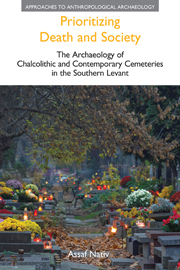 Prioritizing Death and Society
Prioritizing Death and Society Book contents
- Frontmatter
- Dedication
- Contents
- List of figures
- List of tables
- Acknowledgements
- Part I Introduction
- Part II Chalcolithic cemeteries
- Part III Contemporary cemeteries
- 10 An archaeology of us
- 11 The raw materials: from matt to lustre, from grey to colour
- 12 Tombstone morphology: communal trajectories
- 13 Tombstone elaboration: personal expressions
- 14 Spatial patterns: between institutional policy and interpersonal spontaneity
- 15 Intersecting discourses
- Part IV Conclusion
- Appendix: Gazetteers of cemeteries
- Notes
- Bibliography
- Index
10 - An archaeology of us
from Part III - Contemporary cemeteries
- Frontmatter
- Dedication
- Contents
- List of figures
- List of tables
- Acknowledgements
- Part I Introduction
- Part II Chalcolithic cemeteries
- Part III Contemporary cemeteries
- 10 An archaeology of us
- 11 The raw materials: from matt to lustre, from grey to colour
- 12 Tombstone morphology: communal trajectories
- 13 Tombstone elaboration: personal expressions
- 14 Spatial patterns: between institutional policy and interpersonal spontaneity
- 15 Intersecting discourses
- Part IV Conclusion
- Appendix: Gazetteers of cemeteries
- Notes
- Bibliography
- Index
Summary
The application of archaeological methods to present-day contexts and to the recent past has been straddling the side lines of the discipline for approximately five decades now (Gould & Schiffer 1981; Shanks ' Tilley 1992: 172—240; Bailey et al. 2009; Harrison & Schofield 2009; González-Ruibal & Hernando 2010). Its roots are to be found with the positivist movement of processual archaeology that encouraged archaeologists to explore the material culture of contemporary societies and their behavioural correlates (Trigger 2006). It was, however, most likely the call of this movement to discover universal rules underlying human culture that instigated the first calls to abandon the past as a necessary definition of the discipline.
In his formulation of a manifesto for modern material culture studies, Rathje (1979, 1981) cited four potential contributions such endeavours are likely to have for archaeology:
teaching archaeological principles;
testing archaeological principles;
recording the archaeology of today;
relating our own society and culture to those of the past.
It is remarkable that Rathje did not suggest contemporary material culture studies as a field that may have a great deal to offer the understanding of the present per se. Shanks and Tilley (1992: 172—3) rightly noted that, anchored as they were in functionalist and empiricist perspectives of processual archaeology, early studies of present-day material culture tended to produce insights of limited significance, failing to acknowledge its relevance for the understanding of the present.
- Type
- Chapter
- Information
- Prioritizing Death and SocietyThe Archaeology of Chalcolithic and Contemporary Cemeteries in the Southern Levant, pp. 133 - 147Publisher: Acumen PublishingPrint publication year: 2013
